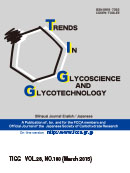All issues

Volume 28, Issue 160
Displaying 1-6 of 6 articles from this issue
- |<
- <
- 1
- >
- >|
MINIREVIEW
-
Hisayoshi Makyio, Ryuichi Kato2016 Volume 28 Issue 160 Pages E25-E37
Published: March 25, 2016
Released on J-STAGE: March 25, 2016
JOURNAL FREE ACCESSFucose-binding lectins play important roles in many biological processes including cell adhesion, infection of host cells by pathogenic bacteria, and binding to glycosylated proteins. Many three-dimensional structures of fucose-binding lectins have been reported. We compiled and compared the fucose-binding lectins whose structures have been solved to date. With the exception of three lone proteins, these lectins can be classified into six families. In this review, we describe the various fucose-binding mechanism of lectins based on their three-dimensional structures.View full abstractDownload PDF (5397K) -
Takuji Oka, Masatoshi Goto2016 Volume 28 Issue 160 Pages E39-E45
Published: March 25, 2016
Released on J-STAGE: March 25, 2016
JOURNAL FREE ACCESSGalactofuranose-containing glycans (Galf-glycans) are found in filamentous fungi, subphylum Pezizomycotina of Ascomycota. Although Galf-glycans have been broadly used as an indicator of pulmonary aspergillosis in clinical settings, and its importance in fungal cell growth is recognized, information pertaining to the galactofuranosyltransferase involved in the biosynthesis of Galf-glycans is sparse. In 2013, we identified and characterized the first galactofuranosyltransferase enzyme (GfsA) for the synthesis of Galf-glycans from a research model fungus, Aspergillus nidulans, and the human pathogen Aspergillus fumigatus. The enzyme belongs to the glycosyltransferase (GT) family 31. GfsA has the ability of transfer galactofuranose residues from the sugar donor UDP-galactofuranose to the non-reducing end of O-glycans in the Golgi apparatus. This review presents the process used to identify the enzyme, its enzymatic features, functions in the cell, and the biosynthesis of Galf-glycans in filamentous fungi.View full abstractDownload PDF (1274K)
MEETING REPORT
-
Yasuhiko Kizuka2016 Volume 28 Issue 160 Pages E47
Published: March 25, 2016
Released on J-STAGE: March 25, 2016
JOURNAL OPEN ACCESSDownload PDF (3538K)
MINIREVIEW (Jpn. Ed.)
-
Hisayoshi Makyio, Ryuichi Kato2016 Volume 28 Issue 160 Pages J25-J38
Published: March 25, 2016
Released on J-STAGE: March 25, 2016
JOURNAL FREE ACCESSFucose-binding lectins play important roles in many biological processes including cell adhesion, infection of host cells by pathogenic bacteria, and binding to glycosylated proteins. Many three-dimensional structures of fucose-binding lectins have been reported. We compiled and compared the fucose-binding lectins whose structures have been solved to date. With the exception of three lone proteins, these lectins can be classified into six families. In this review, we describe the various fucose-binding mechanism of lectins based on their three-dimensional structures.View full abstractDownload PDF (5578K) -
Takuji Oka, Masatoshi Goto2016 Volume 28 Issue 160 Pages J39-J45
Published: March 25, 2016
Released on J-STAGE: March 25, 2016
JOURNAL FREE ACCESSGalactofuranose-containing glycans (Galf-glycans) are found in filamentous fungi, subphylum Pezizomycotina of Ascomycota. Although Galf-glycans have been broadly used as an indicator of pulmonary aspergillosis in clinical settings, and its importance in fungal cell growth is recognized, information pertaining to the galactofuranosyltransferase involved in the biosynthesis of Galf-glycans is sparse. In 2013, we identified and characterized the first galactofuranosyltransferase enzyme (GfsA) for the synthesis of Galf-glycans from a research model fungus, Aspergillus nidulans, and the human pathogen Aspergillus fumigatus. The enzyme belongs to the glycosyltransferase (GT) family 31. GfsA has the ability of transfer galactofuranose residues from the sugar donor UDP-galactofuranose to the non-reducing end of O-glycans in the Golgi apparatus. This review presents the process used to identify the enzyme, its enzymatic features, functions in the cell, and the biosynthesis of Galf-glycans in filamentous fungi.View full abstractDownload PDF (1474K)
MEETING REPORT (Jpn. Ed.)
-
Yasuhiko Kizuka2016 Volume 28 Issue 160 Pages J47
Published: March 25, 2016
Released on J-STAGE: March 25, 2016
JOURNAL OPEN ACCESSDownload PDF (3602K)
- |<
- <
- 1
- >
- >|